Audio Program
Download
Welcome to the 10th edition of “Classic Choice”. Today we present: “Karn Evil 9” by Emerson Lake & Palmer.
Even though the audio program is reasonably self-sufficient, due to the nature of the detailed musical analyses I recommend that you take advantage of the support provided by the written version. That way you, will be able to go through the audio examples at your own pace while you read the corresponding explanations.
In the previous analysis, “The Lamb Lie Down on Broadway” we focused our attention on the rich variety of extra-musical elements that surround the work, and not so much on the music per se. As I explained, the reason for it is that, in spite of the fact that the music is among the finest that Genesis ever made, they developed pieces following simple song structures and also, except for the few examples noted, there was little development of common thematic material throughout the album.
In “Karn Evil 9” however, the situation is exactly the opposite. Although the concept and lyrics are worthy of some analysis, the music itself will center our attention.
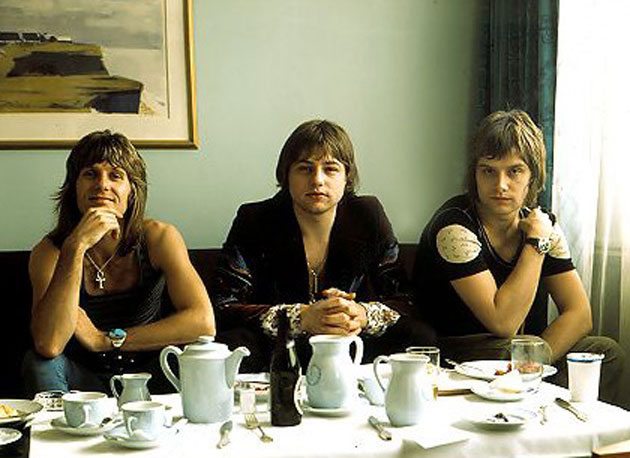
The History
But before diving into the music, let’s explore some of the circumstances around the development of “Karn Evil 9”. The album took over 600 hours to make and was recorded at London’s Advision Studios during August and September of 1973 (except Karn Evil 9 – 1st Impression recorded at London’s Olympic Studios in June).
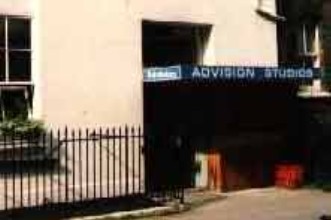
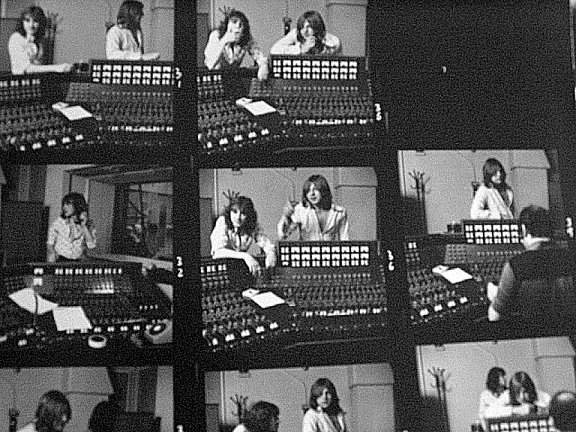
Greg Lake and Pete Sinfield at Advision Studios
This is a nice set of photos of the recording session of “Brain Salad Surgery”, taken from the recommended site www.brain-salad-surgery.de
This implies that there were quite a few work sessions of over 12 hours a day. Some critics said that this was a sign of a band that was running out of ideas. But quite the contrary, it was ELP at their creative peak, striving for perfection. It is also important to note that “Brain Salad Surgery” became the first album ELP released under their own label called “Manticore Records”. It also featured the first polyphonic synthesizer – a prototype Moog Apollo. So, this album was created at a peak moment in their lives from different perspectives: artistic, professional and economic. And it shows. Even the band members themselves recognized “Brain Salad Surgery” and “Karn Evil 9” in particular, as the zenith of their creative output:
Keith Emerson:
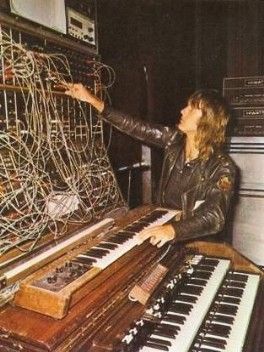
Carl Palmer:
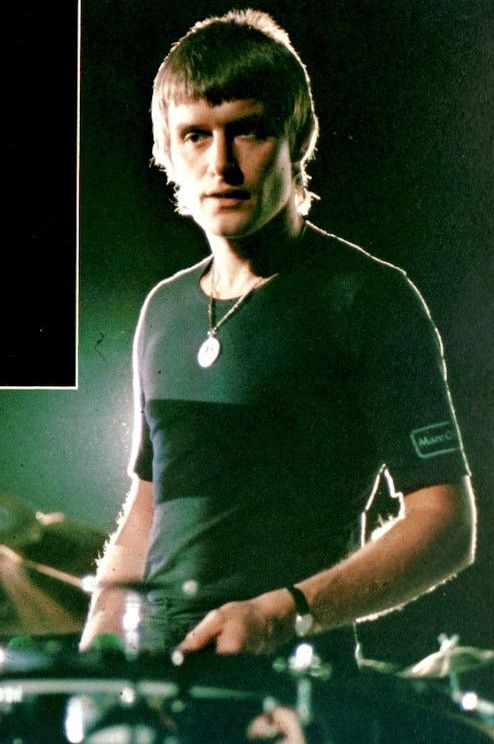
Greg Lake:
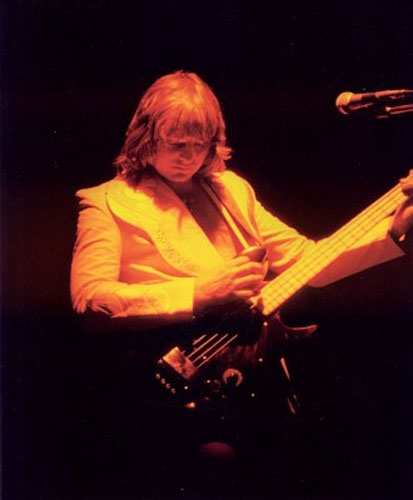
The phrases highlighted are key to the musical analysis that will follow.
The title of the album – Brain Salad Surgery – was probably taken from the lyrics of the song “Right Place, Wrong Time” by Dr. John, released also in 1973:
The Concept
From a conceptual point of view, “Brain Salad Surgery” again, as in “Tarkus”, revolves around the issue of “technology ethics” – the impact of technology in the evolution of human values. Quoting Edward Macan from his excellent book “Endless Enigma”:
As we can see, the questions posed by this conceptual album are even more pertinent today than 45 years ago when this album was released.
“Karn Evil 9” is a suite presented in three parts (I’m regarding parts 1 and 2 of 1st impression as a single piece). The “technological ethics” are approached from different perspectives in the outer movements, while the middle instrumental serves as a vehicle to carry the inertia of the 1st part, on to the 3rd.
The conceptual/narrative premise of “Karn Evil 9” is wonderfully described by Edward Macan. Allow me to quote a fragment from Chapter 9 from his book “Endless Enigma”:
This excellent description of the concept behind “Karn Evil 9” provides more than enough information to allow us to see this magnificent piece from a wider and richer perspective.
By the way, the name “Karn Evil 9” would appear to be a combination of two words that sound like “Carnival” and the 9 comes from Emerson’s original “Ganton 9” concept. Also note that Karn Evil matches the initials of Keith Emerson.
The number of movies, novels and series (Terminator, Matrix and Black Mirror, just to name a few) based on this subject that have appeared since the album’s release, reinforce my previous statement regarding the fact that the issues addressed in “Karn Evil 9” are not only pertinent nowadays, but even prophetic.
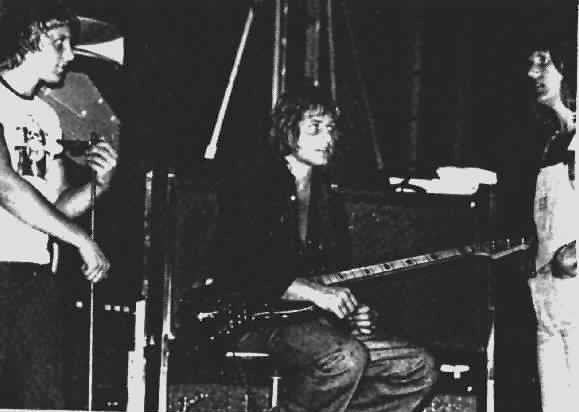
Album Cover
Before getting into the details of the music, let’s discuss the extraordinary album cover, which is always a strong contender when selecting the best rock album covers ever.
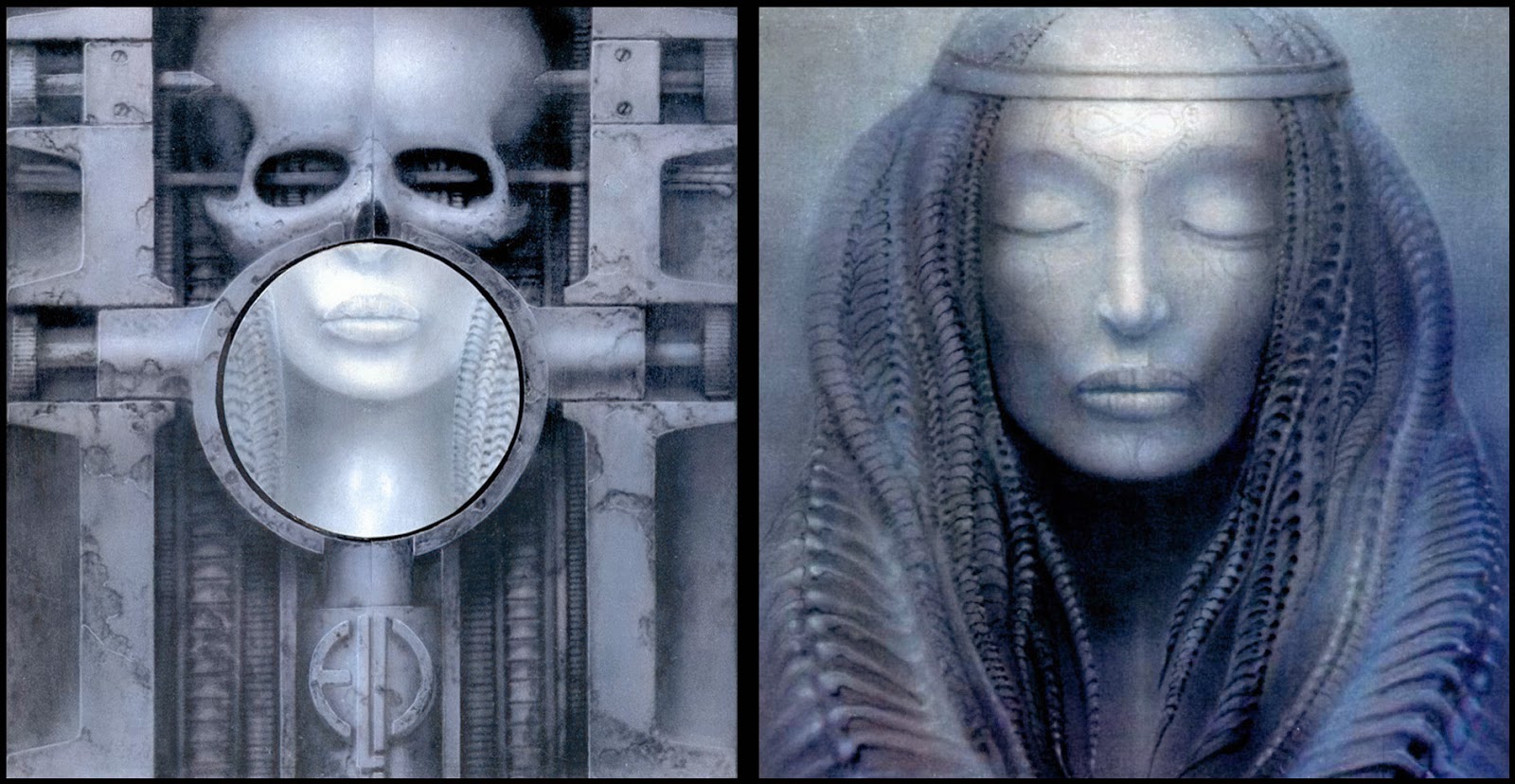
I took a couple of photos of the original booklet included in my 1973 vinyl copy of the album. This is the booklet folded. The meditative woman is replaced by Emerson, Lake and Palmer

When you unfold the booklet, you see on the lower side the full pictures of the band members and in the upper, the lyrics of the album
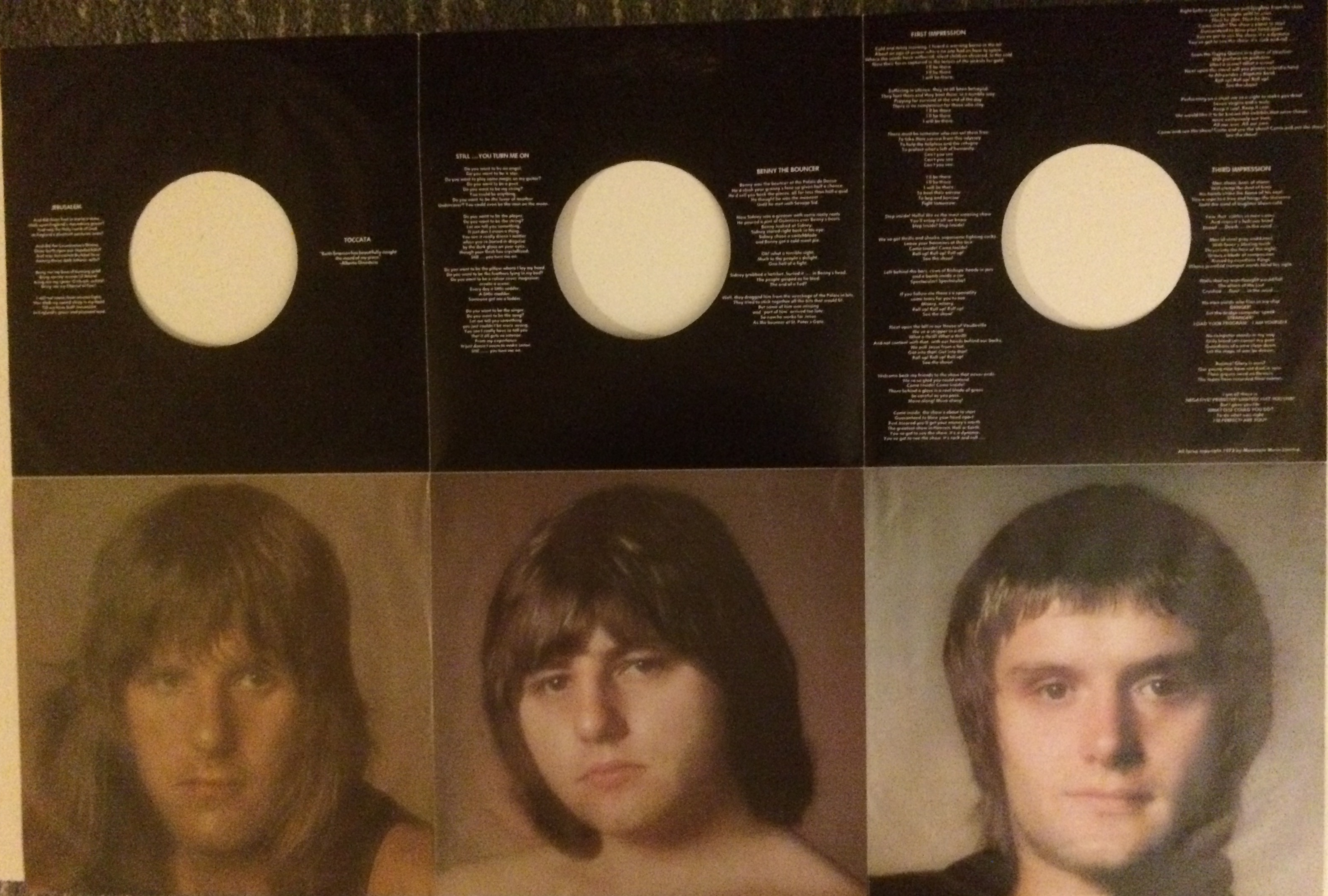
When ELP played in Zurich as part of their European tour in 1973, Emerson was introduced to a surrealist artist called H. R. Giger. He was relatively unknown at the time and later became famous for his participation in the film Alien. Emerson was really impressed:
In a relatively short amount of time, Giger was able to develop his impressive design. The layout is particularly effective in the original vinyl edition: at first sight, you can see a skull imprisoned by some sort of mechanical contraption, but the skull is not entirely deprived of flesh – an inner circle shows part of the skin from the nose down to the neck. The cover opens up in the middle. When you do, a woman seemingly in meditation or asleep, appears with the infinity symbol in her forehead. The woman’s hair would appear to be of some sort of biological reptile origin but if you look closely, you will see that they are formed of mechanical dreadlocks.
This fusion of biological and mechanical elements fit seamlessly into the plot of “Karn Evil 9”: The humanization of the “Man of Steel” in direct proportion to the dehumanization of mankind.
By the way, I think that the aesthetics of the woman’s hair is very similar to what Giger used in Alien.
I encourage you to visit this page, for a more detailed explanation of the process that led to the creation of the cover art and the famous ELP logo. In that article you will see that the two originals (the mechanical skull and the meditating woman) were stolen at an art exhibition in Prague in 2005. HR Giger offers $10.000 to whoever returns the paintings to him.
The Music
There is a key characteristic that affects this whole body of work. Let’s go back to Emerson and Lake comments. Emerson highlights the tighter interplay within the band and Lake remarks the fact that, for the first time, they were more concerned with harmony and melody instead of the technical aspects. If you look back to ELP’s previous albums, you will find that, as a general rule, the bass did not provide much to the overall construction of the harmonies. More often than not, the bass would double what Keith is doing with his left hand, or, just reinforcing a harmonic structure that was completely laid out by the keyboards. A very representative example is the beginning of “Tarkus”. Pay attention to the bass and the lower part of the keyboards.
Beginning of “Tarkus”
While there are many other examples where the bass is indeed supporting the harmony, it usually does so by playing the fundamental note of the chord and doing simple bass patterns. There are not many examples of the bass contributing to the harmonic texture while elaborating long melodies, as is the case with “Karn Evil 9”.
In “Karn Evil 9”, for the fist time, the bass gains full independence and becomes a crucial part of the harmonic structure. This is obvious by listening to the first few seconds of the suite. Listen to the intricate bass pattern, which is not doubled by the keyboard. If you take the bass part out, the whole harmonic foundation falls like a house of cards:
Beginning of “1st Impression”
There is another very relevant aspect that is applicable to the whole suite. It is very common to see how composers that are also excellent players contaminate their works with their virtuosity. Often, you see that their eagerness to show how well they play gets in the way of their creativity. This happens not only in progressive music but also in Classical Music and Jazz as well. In ELP, there are many examples of passages where Lake sits on a fixed harmonic pattern for several minutes, while Emerson performs all sorts of self-indulgent solos that are closer to a circus act than to a music piece. This does not happen in “Karn Evil 9”. There are a few cyclic harmonies with solos on top, but they are restrained and very efficient.
1st. Impression
Let’s take a closer look at the 1st Impression.
The form of this piece is an overarching ABB’, where “A” presents the voice of the “Liberator” and the 2 “B” sections feature the “Carnival barker”. The whole piece would not fit into side “A” of the vinyl, so it was spliced into two parts. However, as I already mentioned, there is no disruption in the musical discourse between parts one and two; in fact, several CD editions eliminate the fades in-out and present the 1st Impression as a continuous piece of music.
PART “A”
The structure of part “A” is based on three verses, each with a preceding instrumental section, a common chorus (I’ll be there, I’ll be there, I will be there), and a coda:
Intro – Verse 1 /Chorus – instrumental 1 – Verse 2 /Chorus – instrumental 2 – Verse 3/Chorus – Coda
As Emerson has pointed out, in “Karn Evil 9” counterpoint was used extensively. In fact, as Edward Macan states,
Intro
The intricate counterpoint texture is made itself evident from the beginning of the piece. See how the melody of the lower voice in the organ is handed over to the bass:
Counterpoint handed over by the organ, to the bass
Also, note that the organ presents a motive that will be used throughout Part “A”:
Organ motive
Verse 1 and Chorus
The vocal melody, is a very simple pattern of 2 alternating notes. However, Lake cleverly plays with the intonation and turns it into a sort of recitative. Without that intonation, the melody would have been extremely dull and boring. The “Liberator” speaks. Note that the organ motive is played between each of the verses:
Cold and misty morning, I heard a warning borne in the air
About an age of power where no one had an hour to spare,
Where the seeds have withered, silent children shivered, in the cold
Now their faces captured in the lenses of the jackals for gold.
I’ll be there
I’ll be there
I will be there.
Now try to dismiss the voice and center your attention on the instruments. The counterpoint, now handed over by the bass to the piano, draws a complicated figure full of dissonances while the organ plays an obsessive pattern that sounds like Morse code. Let’s listen again:
Obsessive organ chords (like some sort of Morse code)
I believe this pattern represents the machine, the “Man of Steel”. See how this pattern is repeated in the 3rd Impression in the instrumental section that precedes the climax of the Suite:
Obsessive repetition, repeated in 3rd Impression
In fact, these patterns based on obsessive repetitions of the same note or chord, which seem to represent machine codes, are present throughout the suite. Here are some examples:
“Machine Code” examples
Instrumental 1
This first instrumental section takes the organ motive from the Intro as a basis for further development, and ends with a repetition of the counterpoint voice in the bass. Note the tight interplay and the fact that the bass is never doubling the organ. It is an indispensable part of the harmonic structure.
Instrumental 1
Verse 2 and Chorus
In the second verse, the complex counterpoint of the piano is replaced by an ascending figure, played by the Moog, based on a pattern of repeated notes. Maybe yet another instance of machine code?
Suffering in silence, they’ve all been betrayed.
They hurt them and they beat them, in a terrible way,
Praying for survival at the end of the day.
There is no compassion for those who stay.
I’ll be there
I’ll be there
I will be there.
Instrumental 2
Again this instrumental section opens with the organ motive but this time leading to a synthesizer solo. Note that now the organ motive is modified and the bass plays an ascending scale that was not used in the previous exposition. At the end of the solo, once again the passage with the bass counterpoint is presented, leading to the third and final verse of part “A”:
Instrumental 2
Verse 3 and Chorus + Coda
In the third verse there is yet another variation: the ascending synthesizer melody is replaced by a frenetic drum pattern based on constant snare rolls and cymbals. Also, the organ motive is not played between each verse; instead a very clever compositional resource is used: the organ is anticipating the sequence chord that will be used in section “B” (the Carnival barker) but at half the speed. I will come back to this in a minute. Let’s listen to the third and final verse first. From a harmonic point of view there are many things going on, but for those with some music knowledge, just note in the coda the change from minor to major and the sudden modulation (reinforced with a gong) to prepare the tonality of section “B”:
There must be someone who can set them free:
To take their sorrow from this odyssey
To help the helpless and the refugee
To protect what’s left of humanity.
Can’t you see
Can’t you see
Can’t you see
I’ll be there
I’ll be there
I will be there.
CODA:To heal their sorrow
To beg and borrow
Fight tomorrow.
Before proceeding with section “B”, let’s go back again to the anticipation technique. Pay attention only to chords played by the organ in the last verse of section “A”:
Anticipation technique. Harmonic progression of section “B” introduced but at half the speed
Now pay attention to the organ chords at the beginning of section “B”. They follow the same harmonic pattern as before, but at twice the speed:
Anticipation technique. Chord progression from section “B” that was previously hinted at…
PART “B”
The form is:
Instrumental + Carnival Barker (three times) + Guitar Solo
Instrumental
This section starts with a long instrumental development with three segments where several aspects need to be highlighted.
In the first segment, the melody is constructed upon a rhythmic pattern in 7/8 separated by a bridge in 8/8. The whole segment is repeated. You can count the beat by following the bass: during the 7/8 it is playing a melodic pattern and in the 8/8 bridge it changes to a pulse with just two notes. Note, once more, that the bass parts are essential because neither the Moog nor the Hammond are doubling the bass. As Macan accurately states:
Try to count it:
Instrumental Introduction to Part “B” – first segment
The second and third segments also present some very challenging rhythmic patterns. The second segment begins with a polyphonic section that resembles part “A” with a wild array of constantly shifting meters until, at the end of the third segment, it finally settles in straight 4/4. A detailed discussion of these complex meters is beyond the scope of these analyses. You might want to try – there’s a bit of everything including 19/8 and 15/8 measures!
Let’s listen to this wonderful instrumental section that precedes the entrance of the “Carnival barker” and again pay attention to the independence between the bass and the lower keyboard parts:
Instrumental Introduction to Part “B” – second and third segments
Carnival barker
This section of part “B” is repeated three times and has the following format:
[Verse 1 + instrumental interlude + chorus] + drum roll + [Verse 2+ instrumental interlude + chorus] + Hammond effects + [Verse 3+ instrumental interlude + chorus]
The three instances are very similar, however, there is a curious effect the first time, just at the word “shock”. There is silence during a split second, but this was not the band stopping but rather the sound being sliced out completely to create the effect. Also, notice that in the third and last repetition, Lake quietly doubles the bass line with his electric guitar, in preparation for the guitar solo that will follow.
Again the bass lines are rich and independent. Listen to the bass pattern during the chorus: “Roll up!, Roll up!, Roll up!”
Verse 1:
Step inside! Hello! We’ve the most amazing show
You’ll enjoy it all we know
Step inside! Step inside!
We’ve got thrills and shocks, supersonic fighting cocks.
Leave your hammers at the box
Come inside! Come inside!
[Instrumental Interlude]
Chorus:Roll up! Roll up! Roll up!
See the show!
[Drum roll]
Verse 2:Left behind the bars, rows of Bishops’ heads in jars
and a bomb inside a car
Spectacular! Spectacular!
If you follow me there’s a speciality
some tears for you to see.
Misery, misery,
[Instrumental Interlude]
Chorus:Roll up! Roll up! Roll up!
See the show!
[Hammond Effects]
Verse 3:Next upon the bill in our House of Vaudeville
We’ve a stripper in a till
What a thrill! What a thrill!
And not content with that, with our hands behind our backs,
We pull Jesus from a hat,
Get into that! Get into that!
[Instrumental Interlude]
Chorus:Roll up! Roll up! Roll up!
See the show!
Guitar solo
The last “Carnival barkers” declaiming, leads to a guitar solo that will take 1st Impression to its first major climax. Now, as Macan aptly remarks, this is no ordinary solo:
Making a detailed harmonic analysis of this guitar solo is beyond the scope of this analysis, but let me assure you that it has been carefully crafted to achieve the wonderful climax that we perceive starting at 8:14. The tempo starts with a compound measure that seems an 8/8 but it is really 3/8 + 3/8 + 2/8; that is, two ternary bits plus one binary beat and then, at 7:31, the tempo changes abruptly to a straight 4/4 coinciding with a strong modulation. This tempo change helps to shift the mood of the piece into an epic character; from this point onwards, the climax is built steadily; the Hammond plays sustained chords and carries the music through several modulations; at 7:55 the rhythmic flow stops, making a series of obbligato blows that lead to the final section where the Hammond changes to rapid chords while the guitar performs scales that continue to rise, adding to the tension and climax.
1st. Impression Part “B” – Guitar Solo
PART B’
1st Impression Part 2, is really the second “B” part of the overarching ABB’ structure of this movement. But this is not a mere repetition of “B”. This part could really be considered a development of “B” because it takes the ideas of the initial exposition but expands in several directions.
One of the virtues of “Karn Evil 9”, is its ability to consistently build several climaxes throughout the suite. After the first climax, the piece starts the climax building process once again, this time starting almost from scratch with only a bubbling Moog and Lake singing “A Capella” what would become a famous phrase: “Welcome Back my Friends to the Show that Never Ends”.
This part incorporates a new refrain, the structure is:
Verse 1 + Verse 2 + Refrain 1 + Verse 3/Refrain 2 + Instrumental interlude (Moog Solo + Guitar Solo)
The guitar solo is a compressed version of the previous solo, and takes us right into the second climax of the movement. After it, we return to the same structure of the 1st part:
Verse 1 + instrumental interlude + chorus
To finish with a Coda that starts with a modified version of the Verse followed by the initial melody at the beginning of part “B”, leading to a fully orchestrated and pompous finale that generates the third and final climax of this movement with a fabulous 2-octave Moog portamento.
Listen to Part “B’” while you follow the reading and the scheme of this part:
Verse 1 (“A Capella”)
Welcome back my friends to the show that never ends
We’re so glad you could attend
Come inside! Come inside!
Verse 2 (with the Hammond following the same rhythmic pattern and chords of Part “B”, but without bass and drums)There behind a glass there is a real blade of grass
be careful as you pass.
Move along! Move along!
Refrain 1 (new melody)Come inside, the show’s about to start
Guaranteed to blow your head apart
Rest assured you’ll get your money’s worth
The greatest show in Heaven, Hell or Earth,
You’ve got to see the show, it’s a dynamo,
You’ve got to see the show, it’s rock and roll ….
Now, a compressed version with Verse and Refrain combined:
Verse 3 / Refrain 2Right before your eyes, we pull laughter from the skies
And he laughs until he cries.
Then he dies! Then he dies!
Come inside! The show’s about to start
Guaranteed to blow your head apart
You’ve got to see the show, it’s a dynamo,
You’ve got to see the show, it’s rock and roll ….
[Hammond solo]
Notice that Emerson has to do the bass part with the Moog while soloing on the Hammond because Lake is complementing the solo with guitar. Also, note that towards the end a second Hammond is overdubbed, adding to the complexity of the solo.
[Guitar Solo]
In spite of the fact that the solo is compressed, the band is able to build momentum very fast in order to reach the second climax point of the movement. Instead of the climax collapse of the first part when suddenly the band comes to a halt leaving a bubbling Moog, this time the tension is kept with a drum solo that introduces Lake again “A Capella”:
Soon the Gypsy Queen in a glaze of Vaseline
Will perform on guillotine
What a scene! What a scene!
The piece returns to the original format of Verse + Instrumental Interlude + Chorus, creating a formal recapitulation just before the Coda (this is reminiscent of the classical Sonata form):
Verse (notice on “Dixie Land” that Emerson interjects a short fragment of “Tiger Rag” on piano)Next upon the stand will you please extend a hand
to Alexander’s Ragtime Band
Dixie Land! Dixie Land!
[Instrumental Interlude] – same as in part “B”
Chorus:Roll up! Roll up! Roll up!
See the show!
[Drum roll]
CODA:
Final Verse (note that, for the first time, a piano is included in this section which adds to the climactic development)
Performing on a stool we’ve a sight to make you drool
Seven virgins and a mule
Keep it cool. Keep it cool.
We would like it to be known the exhibits that were shown
were exclusively our own,
All our own. All our own.
Added verses to end the vocals:
Come and see the show! Come and see the show! Come and see the show!
See the show!
[short drum interlude]
[initial melody of part “B”] But this time, instead of in 7/8, it is played at 4/4!
Final part of the Coda:
Note that before the bombastic and symphonic finale, the whole band plays a succession of rapid chords. This is yet another instance of what I called “Machine Code”.
A wonderful two-octave Moog portamento helps bring the piece to a grandiose finale.
2nd. Impression
This movement was originally conceived as part of a Piano Concerto. Emerson constructed the piece using his usual procedure of juxtaposing radically different blocks of music. The structure is:
A – B – C – D – A
Instead of listening to the entire movement, I will center your attention on interesting highlights.
Section “A”
If you have good music knowledge you might want to read Macan’s interesting analysis where he claims that this section is really a sort of homage to Emerson’s bebop piano heroes like Bud Powell and Hampton Hawes.
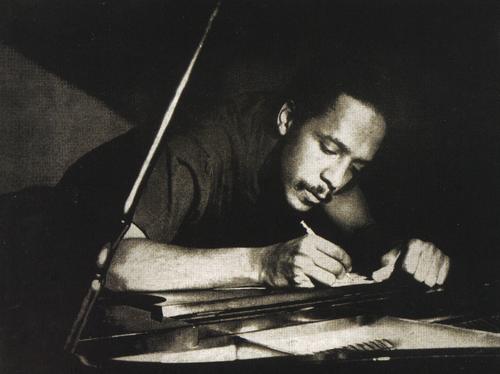
Bud Powell
This section is probably one of the most difficult passages ELP ever performed from a technical point of view. Notice the intricate fabric that is built between the piano and the bass. Section A is repeated and goes from 0:00 to 0:44.
I believe that this section, magnificent in its own right, nevertheless bears no relation to the conceptual flow of the piece.
Section “A” is followed by an extended transition (0:45 to 1:07) that takes us to the famous “Caribbean” section.
Section “B” (Caribbean)
By putting the 3 oscillators out of tune, Emerson is able to very effectively imitate the sound of steel drums.
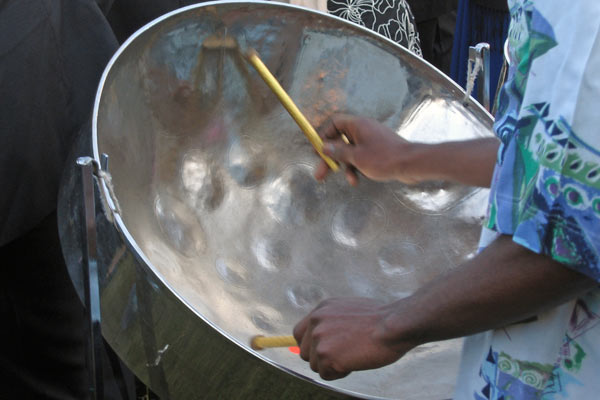
His melody is very well constructed because he takes into account that the steel drums only have a finite number of notes. So, his melody is constructed by using a scale of 6 notes. Also, his use of tremolos between two notes creates a very convincing evocation of the steel drum player doing a roll between two drums. The “Caribbean” section ends with a reference to a melody from saxophonist Sonny Rollins: “Saint Thomas” – one of the first jazz numbers to bear a strong Calypso influence. Let’s listen to the passage that leads to this reference:
Reference from “Saint Thomas” from saxophonist Sonny Rollins
I believe this section does carry some significance with the overall plot of “Karn Evil 9”. The whole section has a strong “mechanical feel”; the bass ostinato and repetitive drum patterns (including the fixed woodblock pattern) help to convey a feeling of artificiality. This is reinforced by Emerson’s incorporation of a vocal sound effect that sounds quite eerie, like some sort of humanoid drowned inside a mechanical contraption:
2nd Impression vocal effect
The closing passage of section “B”, from 2:29 to 2:52, is transitional and leads us to the creepy section “C”.
Section “C”
This section goes from 2:53 to 5:50.
In my opinion, this is the section most closely related to the plot of “Karn Evil 9”. It starts in major mode, but quickly turns into an ominous atmosphere using modal chords, whole-tones, etc. It portrays the preparation for the final battle between Men and Machine – it would seem to be inspired in Giger’s cover art. The woodblocks evoke the ticking of a sinister clock, counting down the time for the final battle. After the two fast sixteenth-note arpeggios, the piano seems to be saying: “Tic-Toc” “Tic-Toc” “Tic-Toc” “Tic-Toc” “Tic…”
Sinister clock
As in sections “A” and “B”, there is a transitional passage before reaching section “D”. It is interesting to note that this section seems to point to a recapitulation of theme “A”; in fact, at 5:44 there is a brief “false recapitulation” that, as Macan describes,
Let’s listen to it:
False recapitulation
Section “D”
Again, this section portrays a mechanical feel. Also, the use of repetitive chords seems to be yet another reference to the “Machine Code”. As in the “Caribbean” section, the bass ostinato and fixed drum pattern help to convey a sense of rigidity that coupled with the almost atonal melody of the piano creates quite a “hellish” landscape:
Section “D”
Reprise of “A”
Section “D” leads to a recapitulation of “A”, this time without repetition:
2nd Impression – reprise of “A”
3rd. Impression
Before discussing the details, I would like to make a rather polemic comment. Those with perfect pitch or tone sensitivity will have noticed that in the live versions of the 1st and 3rd impressions, the key is shifted down by a minor third (from A flat to F). Everybody unanimously say (including the band) that this is was done because it was very straining for Lake to sing every night at such a high pitch, so they had to transport the whole thing (much to Emerson’s frustration). Well, to transport such a complex piece of music implies a very significant effort. No doubt Emerson and Lake were equipped to do that, but believe me, this is no simple task. It is a bit simpler for the bass, but in the case of the keyboards, it means literally relearning the whole thing.
I have a theory: somewhere between the mixing and mastering sessions, someone noted that the outer movements lacked a bit of force. Some parts where maybe a bit too slow. Since we were still in the analog era, increasing the tempo without raising the pitch was not possible. They decided to compromise a bit of tone quality, in order to give the pieces a faster tempo and achieve a more powerful result. There is a very strong argument against this theory: the instrumental Second Impression remained in the same key. Could it be that they were happy with the tempo of this movement but not the other two? On the other hand, I can hear evidence of this manipulation because, at times, Lake’s voice seems artificially high.
Here’s a comparison: the same fragments in the studio version and then the live versions from the album “Welcome Back my Friends” (which was recorded a few months after the studio recording). Note, in the studio version, that the voice is too nasal and has a sort of “metallic” quality which does not correspond to Lake’s vocal texture which is precisely the opposite: warm and round. The tone character in the live version is very different; it seems unlikely that straining the voice a minor third up would produce such a change. In fact, this “metallic” character is present even when Lake is not singing but declaiming (second example).
Of course, this could have been a result of how the voice was equalized in the studio version. Let’s compare:
Voice comparison
So, it seems plausible that the piece was written and recorded in F and that there was never a need to go through such a titanic effort to transport and relearn the whole piece. I’m probably wrong, but I though it’s a theory interesting enough to share with you.
This movement starts with a pompous and British fanfare-like melody. As Macan mentions, Emerson considered the 3rd Impression to be very “Elgarish”, in reference to Edward Elgar (1857-1934), Britain’s greatest composer of the late Victorian period. Quoting Macan:
This is a very apt description for what happens in 3rd Impression. The hymn like tunes that represent Man’s optimism in his fight against machine supremacy are distorted in the passages where the computers seem to fight back.
Throughout this movement, the use of the “machine code” is used very effectively to provide coherence. I will highlight its appearance as we proceed with the analysis of one of the most descriptive pieces in ELP’s catalogue.
The form of the 3rd Impression is similar to the 1st Impression: an overarching ABA’+Coda form.
In the “A” section, we find Lake impersonating the “Narrator” in the Verse sections, and the “Liberator” in the Bridge:
Intro-Verse 1a- (synth motive) – Verse 1b – Instr. Interlude – Verse 2a – (synth motive) – Verse 2b
Bridge – Instr. Interlude – Bridge – Instr. Interlude – Coda (extended Bridge)
SECTION “A”
Intro
Notice how clearly the fanfare and march-like form of the melody and arrangement indicate that a fierce battle is imminent. Palmer’s use of the snare drum emulates the style of a military band:
Intro 3rd. Impression
Verse 1a
Lake assumes the voice of the impersonal narrator:
The “Narrator” speaks
Man alone; born of stone;
Will stamp the dust of time
His hands strike the flame of his soul;
Ties a rope to a tree and hangs the Universe
Until the winds of laughter blows cold.
Keep in mind this short melody in the synth. It will play an important role in the climax of the movement:
Short melody – used in the climax of the 3rd. Impression
Verse 1b
During the second group of verses, appears the first instance of the “machine code” that will be so important in the development of the movement. Listen to the rhythmic pattern underneath the voice, played by drums and bass, starting at the word “ears”:
First instance of the “Machine Code” in 3rd. Impression
Fear that rattles in men’s ears
And rears its hideous head
Dread …. Death …. in the wind ….
In reference to this “machine code”, Macan states:
After a short interlude, the whole Verse section is repeated. Let’s listen to it as we follow the lyrics. Note the modulation and the change from minor to major, right at the end of the passage, in preparation for the Bridge section, when Lake changes from “Narrator” to “Liberator” (in the phrase “dust in the wind”):
Verse 2a – (synth motive) – Verse 2b
Man of steel pray and kneel
With fever’s blazing torch
Thrust in the face of the night;
Draws a blade of compassion
Kissed by countless Kings.
Whose jewelled trumpet words blind his sight.
Walls that no man thought would fall
The altars of the just.
Crushed …. Dust …. in the wind ….
Bridge
Lake assumes the role of the “Liberator” and starts a dialogue with the computer, impersonated by Emerson who processed his voice through a ring modulator (by the way, the only instance of Emerson’s voice in the entire ELP catalogue). Note how the heroic tone of the liberator is reinforced by Lake doubling the voice with a distorted bass. It is also interesting to note that Emerson doubles Lake’s vocal line in imitative mode (creating a brief Canon) with the Moog. Also, instead of singing, Lake declaims the last verse: “let the maps of war be drawn” showing a feeling of frustration when it becomes clear that a battle will be the only way to settle this struggle for supremacy:
The “Liberator” speaks …. and the Computer responds.
No man yields who flies in my ship
DANGER!
Let the bridge computer speak
STRANGER!
LOAD YOUR PROGRAM. I AM YOURSELF.
No computer stands in my way
Only blood can cancel my pain
Guardians of a new clear dawn
Let the maps of war be drawn.
This verse signals the end of section “A”. We now move to the long instrumental section “B”.
SECTION “B”
This long instrumental section represents the battle and can be subdivided into four parts. Parts 1 and 3 would seem to represent the battle from the human’s perspective, while parts 2 and 4 conveys the Computer’s viewpoint:
Human 1 – Machine 1 – Human 2 – Machine 2
Human 1
Note that the melody of the 1st part starts with the same three-note figure of the vocal line from the “A” section. The mood is cheerful, heroic, maybe showing humans a bit overconfident in their ability to control the Computer. The whole part is repeated once:
Machine 1
But the battle is far from over. The “machine code” signals the beginning of this part. The mood changes as the mode shifts drastically from major to minor. Strong dissonances help to convey the Computer’s icy approach, as if slowly but steadily gaining control over human’s will:
Human 2
Another sudden change of tonality signals the beginning of this part, where Mankind put their entire hearts and souls to fight against the Computer’s increasing overall control. This is wonderfully expressed by Emerson’s vigorous solo, among the best in the entire ELP catalogue. Notice however, that towards the end of the solo, something seems to go wrong. Emerson’s solo is interrupted four times by an obscure sequence of ascending chords, until suddenly the “machine code” emerges again. After the first two groups of ascending chords, the Hammond organ responds with fury as if fighting back at the Computers attack but, after the third group of ascending chords, the Hammond’s response introduces a group of repetitive notes – the “machine code”! In other words, the Computer is speaking through the humans!! After the fourth and final group of ascending chords the “machine code” leads to a distorted almost atonal solo, as if the defeated humans were running away. Let’s listen to the final section where all this happens:
Machine 2
This is probably my favorite passage in all of ELPs discography and of one the finest examples of progressive music’s ability to build intense climaxes. It clearly depicts the Computer pressing a counterattack. Notice that the “machine code” pattern is used as a basis for the development of the entire section. The tonal ambiguity helps to create a feeling of anxiety and Emerson superbly starts to use chromatic scales as the basis for building the climax.
In the description that follows, the timing in brackets indicate the relative time within the audio fragment that will follow.
At 6:10 [0:19] mankind seems to fight back, throwing ferocious chords at the Computer but at 6:30 [0:39] the Computer fights back in full force and at that point the strongest climax of “Karn Evil 9” starts to build up. At 6:45 [0:54], the Moog, using a masterfully crafted eerie sound, present chromatic scales that move up and down and start ascending to increase the tension. At 7:10 [1:19], we have, on the right speaker, the Humans, represented by a fanfare; and on the left speaker, the Computer, represented by a synthesized sound that surges up using a portamento (glissando). They seem to be approaching one another and, what follows, is a stroke of genius: Mankind’s motive (the one presented within the verses in part “A”) is responded by the Computer with a synthesizer sound effect at 7:18 [1:26], which is the climax of “Karn Evil 9”. Let me reinstate this: the climax of the piece is not a chord, or a melody – it’s a sound effect!!!! I’ve been aware of this since I was 15 years-old and I cannot listen to this sound effect without getting goose-pumps.
I don’t want to break the listening momentum at this point, so I will briefly discuss the “A’” part of this movement. I will put the entire fragment at the end.
A strong fanfare supported by a drum solo, leads to the final section of “Karn Evil 9”. This fanfare, is actually a development of the dissonant fanfare that closed the “A” section of 1st Impression. Let’s compare:
Fanfare comparison
Section “A’” + Coda
The lyrics of the section carry a strong irony in the verse: “their graves need no flowers; the tapes have recorded their names”. Could it be that Computers become so much a part of Humans that we are no longer conscious of their presence? We believe that we have won the battle, but in reality, the enemy has become a part of us. I believe this idea is reinforced by the last pulsating chords before the famous sequencer starts its melody. Humans and Machines are now one and the same…
Let’s now listen from the last part of “B” (that is, from Machine 2) to the end of the suite, with the interpretation just discussed. I suggest that you read the descriptions once more before hitting the play button. I have marked the relative times in bold, so you can easily spot them as you listen to the last part of this great work of art.
From “Machine 2”, to the end of 3rd Impression
Rejoice! Glory is ours!
Our young men have not died in vain,
Their graves need no flowers
The tapes have recorded their names.
I am all there is
NEGATIVE! PRIMITIVE! LIMITED! I LET YOU LIVE!
But I gave You life
WHAT ELSE COULD YOU DO?
To do what was right
I’M PERFECT! ARE YOU?
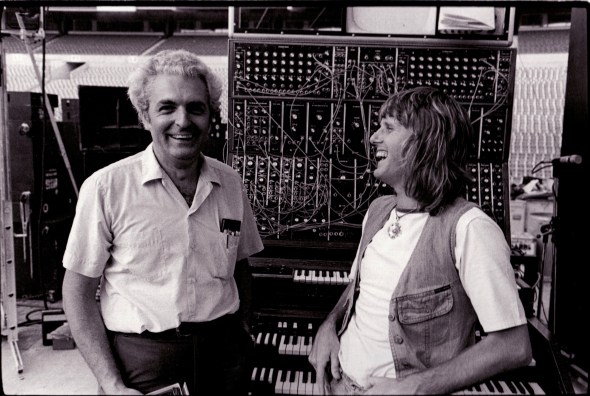
Keith Emerson with Bob Moog
Resources
As shown by the multiple references throughout the analysis, the book “Endless Enigma” written by Edward Macan – Open Court Publishing Company, 2006 was an invaluable source for musical, historical and conceptual information. If you are really interested in ELP, and are ready to plunge into its more than 800 pages, then you should seriously consider acquiring this book. Just a word of warning: if you have little or no music knowledge you will have to skip the numerous musical analyses. It can be purchased here.
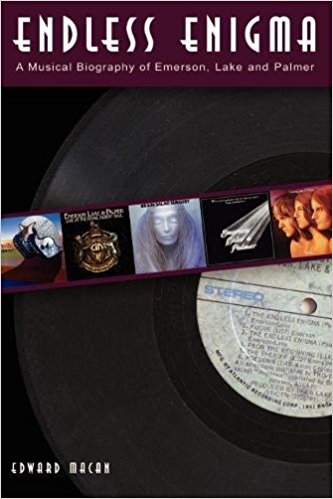
The site http://www.brain-salad-surgery.de/ proved to be an excellent source for facts and pictures. This site, specialized on “Brain Salad Surgery” is recommended for those who want more detailed information about the album.
This interesting video shows footage of the rehearsal sessions of “Brain Salad Surgery”. Note that, more than rehearsals, they were actually working on the generation of the arrangements:
Background Music
For this analysis we have featured two great albums released in 2017 from the Spanish projects “Last Knight” – their album “Talking to the Moon” (https://lastknight.bandcamp.com/album/talking-to-the-moon ) and “Tricantropus” – album “Scrum” (http://www.tricantropus.es)
In order of appearance:
- Moonwalking (Last Knight)
- Scrum (Tricantropus)
- Twilight (Last Knight)
- Sola (Tricantropus)
- Moonrider (Last Knight)
- Hojas Muertas (Tricantropus)
- In the Dark (Last Knight)
- Black Moon (Last Knight)
- El Año del Dragón (Tricantropus)
- The Nightmare (Last Knight)
This is the well-known video of Karn Evil 9 – 3rd Impression, from their performance at the 1974 California Jam:
Ever wondered how would Karn Evil 9 sound as a chamber piece? Well, listen to this superb arrangement of Karn Evil 9 – 1st Impression, Part 1 by the “Morgaua Quartet”:
And how about a Military Band arrangement?
And a Jazz band?

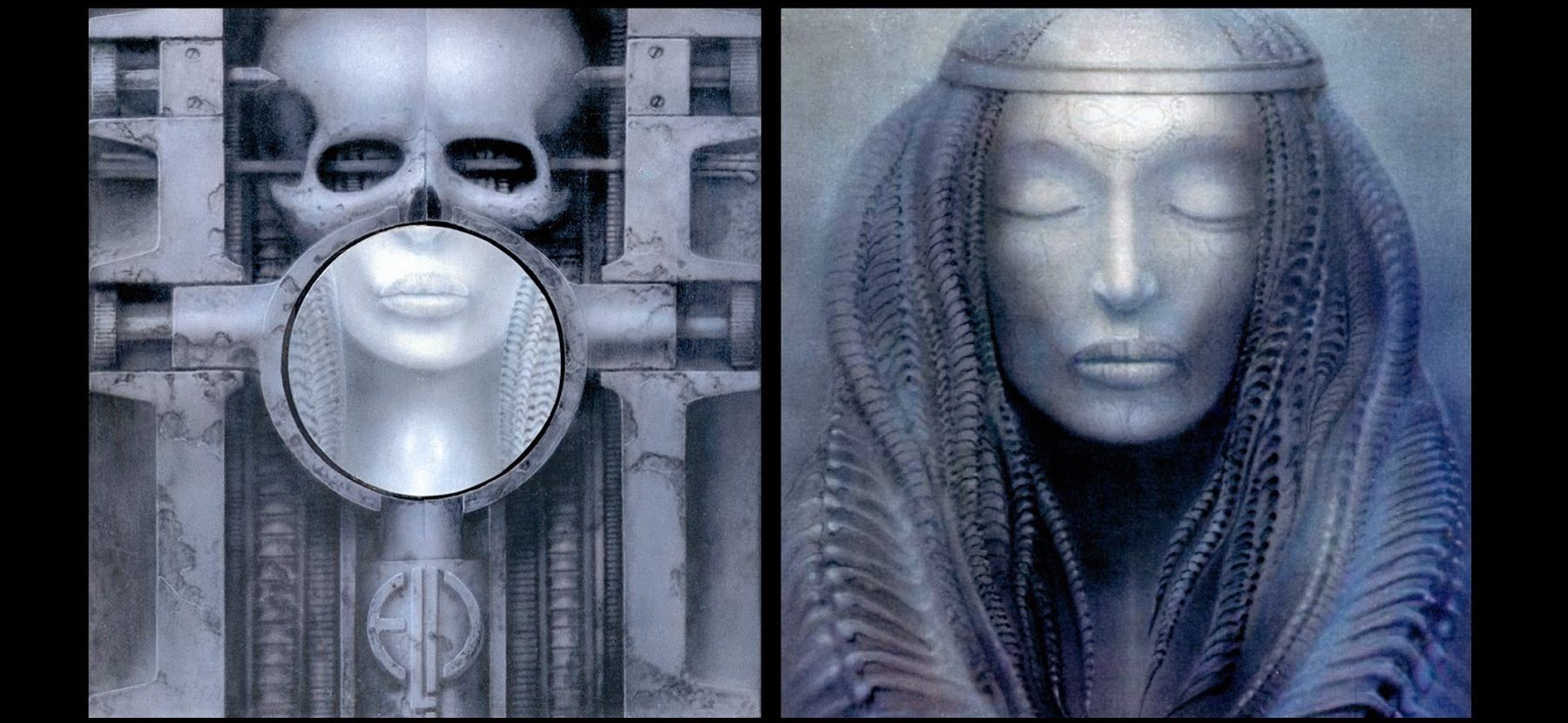
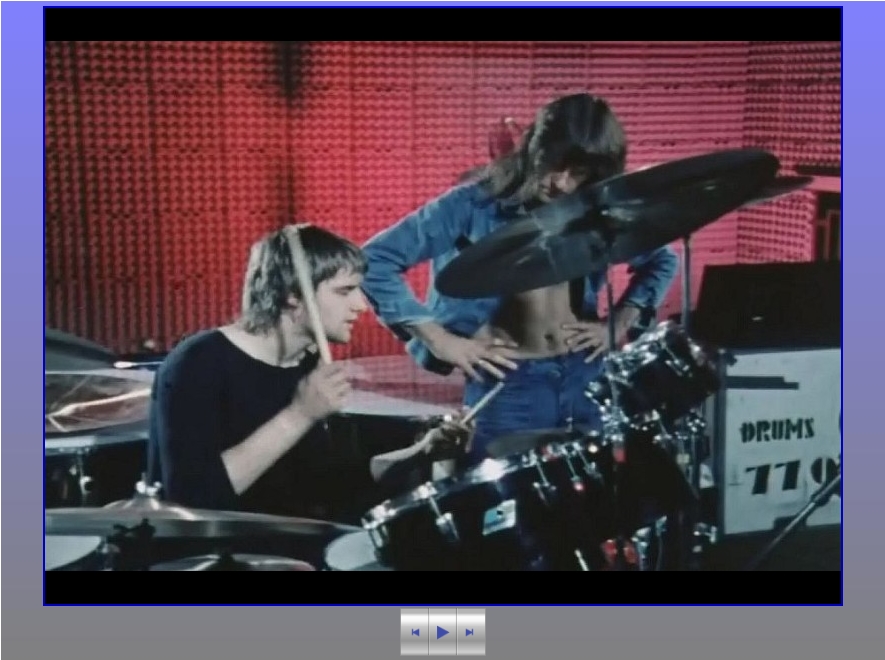


As always brilliantly researched and explained! PS the audio section of 1st Impression Part B guitar solo is missing, those damned computers lol! For me (and others I am sure), me not really a trained musician this is a super complex piece, even if I won’t be able to reach these musical heights, this music and others like it will serve as an inspiration when we are behind whatever instrument or/and are trying compose something.
Thanks for your comments Rob. BTW I checked the audio that you mention and it seems to be working fine. Sometimes it takes a while for the audio to buffer, so you might want to try again. If it still happens, please let me know because I will need to investigate more.
I stand corrected, I guess at the that moment my machine was having trouble with it at the time because I tried that section several times without success while others played easily. I checked it now and it played fine. It is an older ipad I was using before which maybe caused the error.
Glad to know!
An ELP question that is an enigma… why did they drop the song Trilogy out of their live set so fast, it is such a cool song, any ideas… A tricky melody line to sing live maybe or just didn’t work live?
I probably partly answered my own question. I read an ELP biography years ago, I don’t remember all the details. Was just trying to think from a purely musical point of view.
Well, one of the things ELP wanted to achieve with Brain Salad Surgery was a more “direct” sound. They wanted to arrange the pieces in such a way that they could play them live just as they appeared on record. In “Trilogy” there was a lot of overdubbing; just take Abaddon’s Bolero as an example. They tried to play it live with lake playing some keyboards but it just didn’t work out. I guess with Trilogy they found that the intermediate section ended up sounding too thin because Emerson could not play all the parts. Maybe the difficulties they had trying to adapt live some of the pieces in “Trilogy” is why they decided to change their arrangements approach for the following album.
That makes sense, thanks for the reply. Although when they went back on tour in the 90s they could of used modern sampling techniques, but they probably didn’t want to go back to that stuff. It would of been interesting to hear Greg sing Trilogy with a mature baritone profundo voice 🙂
Yes I also think BSS is their peak, yet I truely think Trilogy also has some very wondederful music for listeners and musicians waiting to be discovered in years to come.